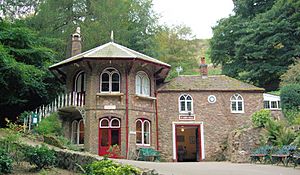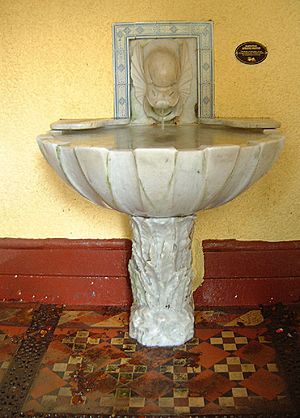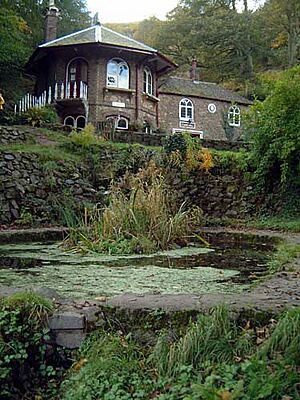St. Ann's Well, Malvern facts for kids
St. Ann's Well is a special place located on the side of the Malvern Hills in England, near Great Malvern. It's a popular spot on the path that leads up to the Worcestershire Beacon. The well is also found on the last part of the Worcestershire Way walking trail.
This spring or well is named after Saint Anne. She is known as the grandmother of Jesus and is a patron saint for many wells.
The building around the well was built in 1813. Inside, clear Malvern water flows out from a beautifully carved spout. There's also a small cafe there. A long time ago, in the early 1900s, a company called Burrows used to bottle and sell water from this very well. They called their bottled water "St Ann's Well" brand.
Contents
What's in a Name?
St Ann's Well is a natural spring. Some people, like Roy Palmer, think it might have been named after Anu. Anu was a Celtic goddess of water from ancient times. An old writer from the 1800s thought that "St Ann's Well" simply meant "the well dedicated to the sun."
A Look Back in Time
The Story of St. Werstan
One important event in Malvern's history is the arrival of St. Werstan. He was a monk from a Saxon monastery that was destroyed by Vikings. Werstan escaped and found safety on the Malvern Hills, close to St. Ann's Well.
Legend says that the town of Great Malvern started after St. Werstan was killed. Even if some parts are just old stories, historians believe he was a real martyr (someone who died for their beliefs). People think St. Werstan's small chapel was where a Victorian house called Bello Sguardo now stands. When an old cottage on that site was taken down in 1825, old carvings, bones, and parts of a coffin were found.
A stained-glass window from the 1400s in Great Malvern Priory shows St. Werstan's story. It shows his vision, his chapel being blessed, and King Edward the Confessor giving permission for the site.
Water for Healing
People knew about the good quality of Malvern spring water even in the Middle Ages. The pure water from St Ann's Well was especially famous in the 1400s. People believed it could cure "many sicknesses." An old song from the 1600s talks about the well's healing powers:
Out of thy famous Hille
So Prayse the Lord!
There daily springeth
A water passing still
That always bringeth
Great comfort to alle them
That are diseased men
And makes them well again
Dr. John Wall's Work
The fame of St Ann's Well water grew thanks to Dr. John Wall. He was a doctor from Worcestershire. In 1745, he studied the water and found that its power came from its "great purity." Dr. Wall wrote a book in 1757 about his findings and amazing cures. He wanted to raise money to improve the simple building at St Ann's Well. His research showed that people needed to drink the water right there and regularly for it to work.
The Well House was built in 1813. Lady Emily Foley owned it and allowed everyone to drink the spring water for free. St Ann's Well was a very popular place for wealthy people seeking the Water Cure in its early days. The unique eight-sided part of the building was added in 1841.
Queen Adelaide visited St. Ann's Well in September 1842.
In the 1850s, John and William Burrow bottled water from St Ann's Well. This happened at their Bottling Works Spring in Great Malvern. Bottling stopped there in the 1950s. The water for this bottling plant was piped directly from St Ann's Well.
In 1866, John Down opened a photography studio at St Ann's Well. He used the spring water to develop his photos. He also built a camera obscura nearby, which is a device that projects an image of its surroundings.
In 1892, Lady Foley gave a beautiful Sicilian marble spout and basin. The spout looks like a dolphin's head above a shell-shaped basin. A plaque above it reads:
Drink of this crystal fountain
And praise the loving Lord
Who from the rocky mountain
This living stream out-poured
Fit emblem of Holy Fount
That flows from God's eternal mountThis marble tablet was placed at St Ann's Well by the Rt Hon Lady Emily Foley of the Manor of Gt Malvern Oct 1892.
The lines were composed by the Rev W Blake Atkinson Rector of Bradley Nr Redditch.
Old Moses the Donkey
From at least 1817, donkeys were used to carry visitors up the hills. By 1852, there were many places to hire donkeys. One special donkey named Old Moses carried a young Princess Victoria to St Ann's Well. There, she officially opened a new path.
Blind George Pullen
George Pullen was a blind musician. He played his harmonium and dulcitone almost every day for 50 years. He started around 1880 and entertained visitors to St Ann’s Well. People say he could "recognise the sound of regular visitors’ footsteps." He would then play their favourite tune as they came closer.
Restoring the Gardens
In 2005, the gardens at St Ann's Well were restored. This work was done by the Malvern Spa Association and other groups. A grant from the Heritage Lottery Fund paid for the work. On December 9, 2005, over 100 people celebrated the completion of the project. Music was played, including a 17th-century song about Malvern water.
St Ann's Well in Culture
New Age Ideas
Alfred Watkins believed that St Ann's Well was the start of a ley line. A ley line is a straight line that connects ancient sites. He thought this line went along the Malvern ridge. It passed through other wells like the Holy Well.
In 1979, Paul Devereux suggested a 10-mile "Malvern Ley." He thought it went through St Ann's Well and other places. British author John Michell wrote that a place called Whiteleaved Oak is special. He said it is equally far from Glastonbury and Stonehenge.
Since 2008, a "Blessing of the Waters" service has been held at St Ann's Well. It includes songs and blessings from many different faiths.
Malvern Fringe Festival
Until recently, St Ann's Well was the starting point for the annual Malvern Fringe Festival May Day parade. The first parade was held in 1994.
Music, Poetry, and Dance
Nigel Kennedy, a British violinist, has played and recorded music in the Octagon room.
Dick McBride, an American beat poet, read his poems in the Octagon room in 2004.
Robin Broadbank, a flamenco guitarist, performed at the Octagon room in October 2004.
The band Flatworld recorded their album at St Ann's Well in 2005.
In July 2009, over 100 Morris dancers took part in a "Day of Dance" at St Ann’s Well. They came from all over the country.





